The Benefits of Vitamin D: 9 Supplements to Choose from

Vitamin D is unlike any other vitamins required for your health. What are the benefits of vitamin D? Are the benefits of vitamin D3 any different from D2? Are supplements with these compounds really necessary? Read on, and you will find the answers to these and numerous other questions.
1. What Is It?
Vitamin D (calciferol) is a group name for two similar vitamins: D2 (ergocalciferol) and D3 (cholecalciferol). Unlike all other vitamins that need to be obtained solely from food, calciferol can be synthesized by the skin when it is exposed to direct sun rays.
What is D3 vitamin good for? This compound:
- Promotes calcium absorption in the intestines, which is extremely important for bone density and strength
- Stimulates the immune system and helps the body resist infections
- Helps muscles keep their strength
- Can reduce the risk of multiple sclerosis
- Can reduce negative emotions
- Important for neurodevelopment
- Considerably reduces the risk of type 2 diabetes
- Helps women avoid the development of various health conditions during pregnancy,
What’s more, the deficiency of calciferol was linked to such conditions as autism, dementia, depression, and schizophrenia. Children with attention deficit hyperactivity disorder (ADHD) often demonstrate lower calciferol levels. People with Crohn’s disease and ulcerative colitis also frequently have levels of vitamin D.
2. What Can Cause Vitamin D Deficiency?
To synthesize vitamin D your skin needs to be directly lit by a component of sunlight that is invisible to the eye. Called ultraviolet B (or UVB), it covers wavelengths of 290–315 nm. Most of the UVB that comes from the Sun is blocked by the ozone layer of our planet, and only small quantities of it reach the ground. UVB is easily stopped by glass and plastic and this is why exposure to sunlight that comes through windows won’t work.
While, in theory, to get enough calciferol you only need to expose your face, arms, and legs (40% of the skin) to the sun for 20 minutes a day, in reality about a billion people worldwide suffer from inadequate calciferol synthesis. The factors for this are:
- Advanced age: elderly people have skin that is less thick which leads to them absorbing less UVB.
- Not enough skin fat: as calciferol is fat-soluble, it needs some fat to be stored after it is synthesized. The leaner you are, the higher the risk of deficiency.
- Obesity. While the mechanism of this relationship is still unclear, the risk of deficiency markedly increases in people who are overweight or obese.
- Use sunscreen with an SPF rating higher than 8 and wear a lot of clothes when outdoors
- Seasonal variations of sunlight intensity (especially in regions that are far from the equator). In general, the further north/south you live, the higher your risks of calciferol deficiency are.
- Air pollution in large cities that furtherly blocks UVB from reaching the ground.
- Dark skin. The higher the melanin content in your skin, the darker it looks and the better you are protected from the potentially dangerous UV-radiation. Unfortunately, though, this also means that less UVB can penetrate into the skin and, therefore, less calciferol is produced. On average, people with darker skin need up to five times longer sun exposure than those with white skin.
- Chronic health conditions like celiac disease, inflammatory bowel disease, and short bowel syndrome.
- Chronic liver disease
- Use of antiseizure medications (including Phenobarbital) and glucocorticoids (including Prednisolone and Dexamethasone) that activate degradation of calciferol in the body.
- Individual genetic anomalies.
3. What Are the Symptoms of Vitamin D Deficiency?
What D3 vitamin does for your body can be clearly seen from the range and severity of symptoms of its deficiency. They include:
- Weak muscles and fragile bones with significantly increased risk of fracture
- Reduced blood calcium, which leads to muscle aches and twitching
- Inflammation of gums (periodontitis) which leads to tooth loss
- Weakened immune system (higher frequency, longer time, and greater severity of all kinds of contagious infectious diseases)
In children calciferol deficiency leads to the development of rickets. Children with this condition suffer from soft and weak leg bones that bow at the knees, and their growth rate is markedly reduced.
In many cases, though, calciferol deficiency causes very few symptoms and can only be detected using a series of medical tests. If left untreated, it continues to undermine the health of the body until a serious condition (very often, osteoporosis) develops.
4. What’s the Form with the Most Benefits of Vitamin D?
As calciferol has two main forms — ergocalciferol (D2) and cholecalciferol (D3), you might wonder which of them is more effective.
Studies demonstrate that D3 is almost twice as effective compared to D2 at raising levels of calcifediol in blood. What’s more, D2 has a shorter half-life in the body compared to D3, which means that the body has an opportunity to utilize D3 for a longer time compared to its D2 counterpart. Thus, if you can choose what kind of supplement to buy, always decide on vitamin D3 or cholecalciferol.
One reason why D2 is being manufactured and sold is that it is cheaper to produce and, therefore, supplements with D2 are a bit more affordable. However, nowadays, its price difference with D3 is not very great.
Another reason that used to be of great importance to vegans is that historically D3 was derived from animal sources, while D2 was obtained from mushrooms and yeast grown in UV light. Luckily, these days there are vegan-friendly D3 supplements that are derived from lichen and algae.
If, for some reason, you want to use a D2 supplement, here is one of the highest-rated products available on iHerb:
Vegetarian Dry Vitamin D by NOW Foods
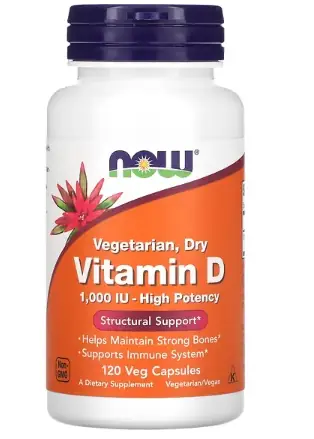
- 120 capsules
- 1,000 IU of ergocalciferol (D2) per capsule
- Reputable brand
- Affordable price
And if you want to use a vegan-friendly D3 supplement, here is a popular product that comes from a well-known brand:
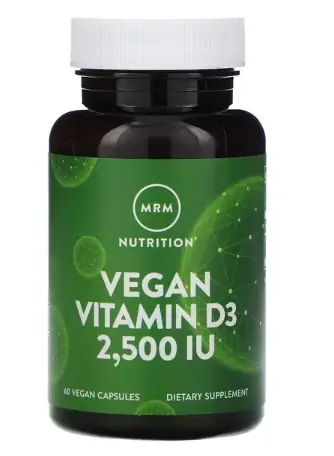
- 60 capsules
- 2,500 IU of cholecalciferol per capsule
- Benefits for vegans: D3 is obtained from lichen extract
- Certified vegan
5. How Much Vitamin D Should I Take?
There are two main units in which quantities of vitamin D are measured: micrograms (shortened as mcg or μg) or international units (IU). The rate of conversion is the following: 1 mcg equals 40 IU.
In the United States, the recommended daily intake (RDI) for ages 1-70 is 600 IU (15 mcg). People who are over 70 need to take slightly higher quantities of 800 IU (20 mcg) per day.
Still, you can use a higher dosage of calciferol if you want to make up for its deficiency as quickly as possible. In the US, the tolerable upper intake (the one which is highly unlikely to cause any side effects) for ages 9+ is 4,000 IU (100 mcg).
D3 is normally fat-soluble; thus, most of the available supplements for adults offer it in the form of oil-filled softgels.
You can buy cholecalciferol products in a high range of dosages. If you prefer to use the doses that are close to the RDI, use this supplement that comes from a trusted brand:
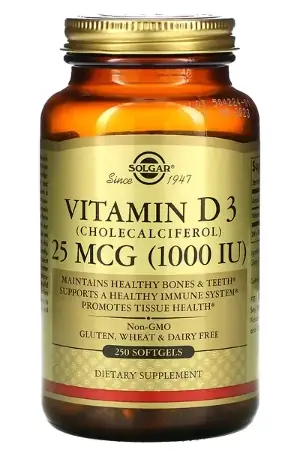
- 250 softgels — enough for 8 months of use
- 1,000 IU (25 mcg) per softgel
- Cholecalciferol is dissolved in safflower oil
- What are the benefits of taking vitamin D3 1000 IU? This dose fully prevents healthy individuals from developing calciferol deficiency.
Here is an affordable high-dose supplement:
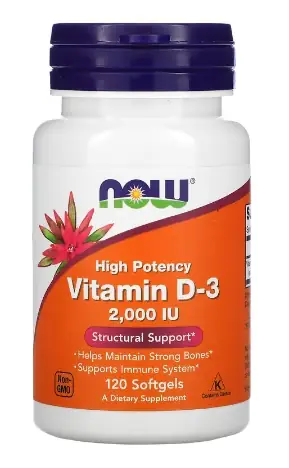
- 120 softgels
- 2,000 IU (50 mcg) per softgel
- Cholecalciferol is dissolved in extra virgin oil
- The benefits of vitamin D 3 2000 IU softgels are that you can use them (one or two a day) to quickly make up the deficiency
6. Vitamin D Supplements: Other Forms
Children usually have difficulty swallowing capsules and softgels; thus, they need to use other supplement forms. These kids-friendly supplements feature modified versions of D3 that can be dissolved in water or made solid.
Here are one of the most popular gummies with calciferol on iHerb:
Vitamin D3 Gummies by Nordic Naturals
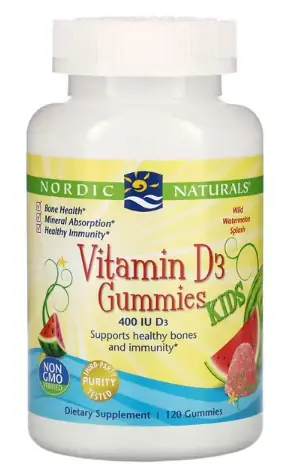
- Reputable brand
- 120 gummies with no artificial colors, flavors, and sweeteners
- 400 IU (10 mcg) of cholecalciferol per gummy
- Benefits of vitamin D3 gummies: pleasant taste and low dosage that is ideal for children
Alternatively, you can choose animal-shaped chewable tablets that children absolutely adore:
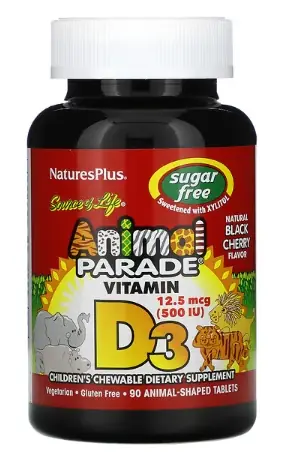
- 90 tablets each containing 500 IE (12.5 mcg) of cholecalciferol
- Contains no sugar (sweetened with xylitol)
- Natural cherry and raspberry flavors
And here is water-based cholecalciferol that will be ideal for infants and toddlers:
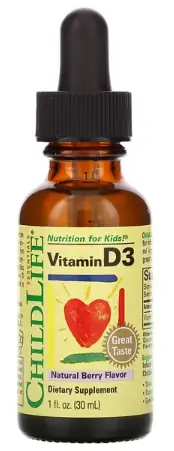
- 30 ml (1 fl. oz) or approximately 920 drops
- Each drop contains 62.5 IE of cholecalciferol
- 8 drops contain 500 IE of cholecalciferol
- 6 drops contain 375 IE of cholecalciferol
- Natural berry flavor
If you want to use D3 to prevent osteoporosis which is a common condition in elderly people, here is a complex formula that combines cholecalciferol with another bone-supporting vitamin K2.
Vitamins D-3 & K-2 by NOW Foods
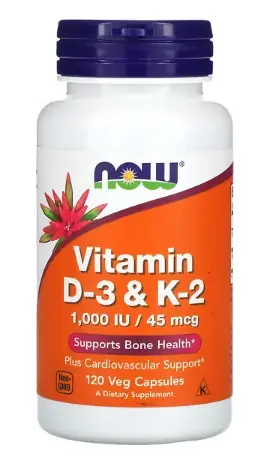
- 120 capsules
- Each capsule contains D3 (1,000 IU) and K2 (45 mcg)
- Benefits of vitamin D3 and K2 complex supplement are bone health protection and dosage that is optimal for the elderly
7. Can I Get D3 from Food Sources?
Contrary to popular belief, there are some quantities of cholecalciferol in various foods, but you are very unlikely to get all the calciferol you need from food sources alone.
| Type of food | IU per gram | Quantity of food to eat daily to get 600 IU | |
| grams | pounds | ||
| Canned sardines (in oil) | 1.9 | 315.8 | 0.70 |
| Canned tuna (in oil) | 2.7 | 222.2 | 0.49 |
| Cooked beef liver | 0.5 | 1 200.0 | 2.64 |
| Cooked egg yolk | 0.7 | 857.1 | 1.89 |
| Cooked pink salmon | 5.2 | 115.4 | 0.25 |
The table shows that to get enough cholecalciferol you need to eat about 2 pounds of egg yolks or 2 and a half pounds of beef liver every day — or a lot of canned fish. The only viable food source of calciferol is pink salmon.
Alternatively, you can use cod liver oil that is directly obtained from freshly caught cod. Not only is this product rich in D3, it also contains significant quantities of vitamin A and essential omega-3 acids.
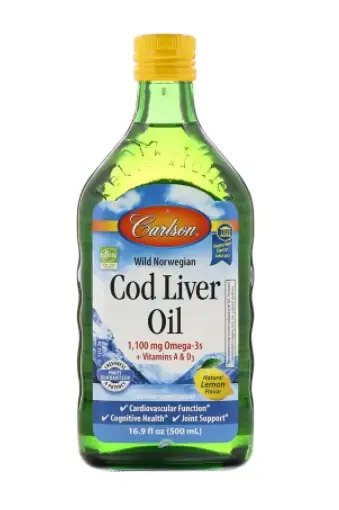
- Benefits of this form: 400 IU of D3 per serving
- High omega-3 content (500 mg of DHA and 400 mg of EPA)
- Bioavailable form of vitamins A (28% of recommended daily value) and E (45% of RDV)
- Natural lemon flavor & no artificial preservatives
8. Can Vitamin D3 Be Overdosed?
First of all, calciferol you get from sun exposure cannot be overdosed: any excess quantity of it immediately breaks down after it is synthesized. Still, direct sun rays are detrimental to your skin and can lead, among other things, to wrinkles and hyperpigmentation.
Cholecalciferol that you get from food supplements can be toxic if you take them in very high quantities. Keep in mind that you will get absolutely no additional benefits of vitamin D3 taken in 50 000 IU doses, and your health can be significantly damaged. Symptoms of overdose include:
- thirst
- increase in urination
- vomiting and nausea
- weakness
- insomnia
If prolonged and untreated, this condition can lead to kidney failure and painful deposits of calcium in the kidneys, heart, and liver with irreversible damage to these organs.
While toxic effects are most likely if you regularly take more than 40,000 IU (1,000 mcg) of cholecalciferol per day, it is recommended that you never exceed the above-mentioned tolerable upper intake for age 9+ of 4,000 IU (100 mcg) of it per day.Now you know what are the benefits of vitamin D and its D3 form to health. Even if you take dietary supplements, never neglect to have a healthy diet and get enough exercise. Take care and see you next time!